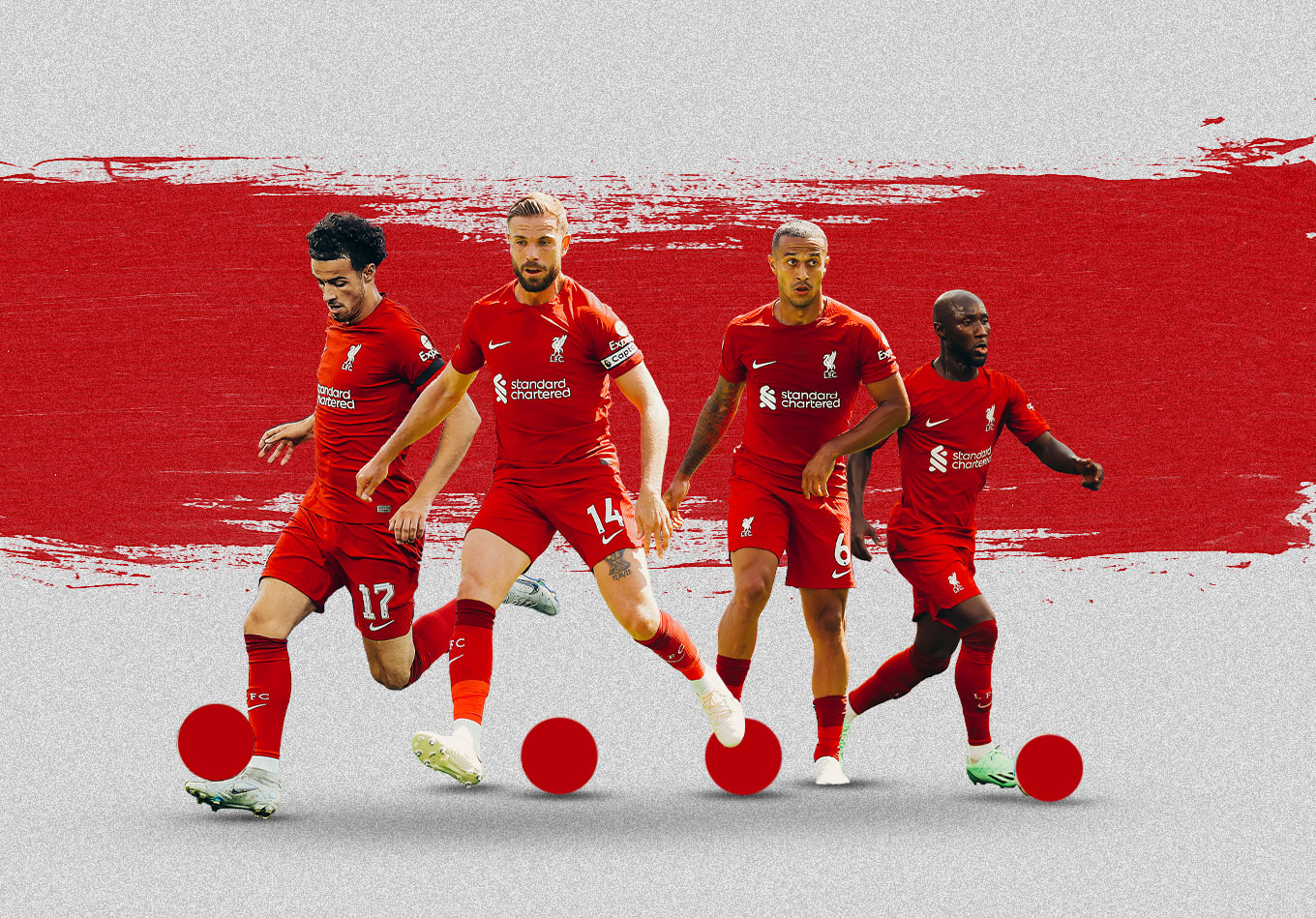It’s not been the start Jürgen Klopp was hoping for. For only a fifth time since World War II, Liverpool have failed to win any of their opening three league games of a season.
A condensed schedule hasn’t helped. Liverpool had just 63 days between the final game of last season – the Champions League final defeat to Real Madrid – and the first game of this term against Manchester City in the 2022 Community Shield. Only twice previously have the club ever had as short a gap between the end of one campaign and the beginning of the next, one of which was due to the Covid pandemic in 2020.
And this comes after Liverpool had a relentless 2021-22 season, reaching every single cup final available to them while also taking the Premier League title to the wire, missing out to Man City by a point.
This has led to difficulties for Klopp early doors in 2022-23. He’s made seven starting XI changes in Liverpool’s first three matches – no Premier League side has made more so far. In fact, in all competitions, Klopp has made at least two changes to his starting XI in 44 of Liverpool’s last 45 matches.
While most of that has been to keep players fresh when playing every midweek and weekend game possible, a lot has been forced upon the German. Liverpool were missing no fewer than 10 players for the visit to Old Trafford last time out. There was a lot of criticism over Liverpool’s starting line-up in that defeat to rivals Manchester United, but there weren’t a great deal of options available to Klopp.
Coupled with all the changes made, this is an ageing Liverpool squad. In the Premier League, their starting XI average age so far this season is 28 years and 163 days old and second only to West Ham in the first three matchdays.
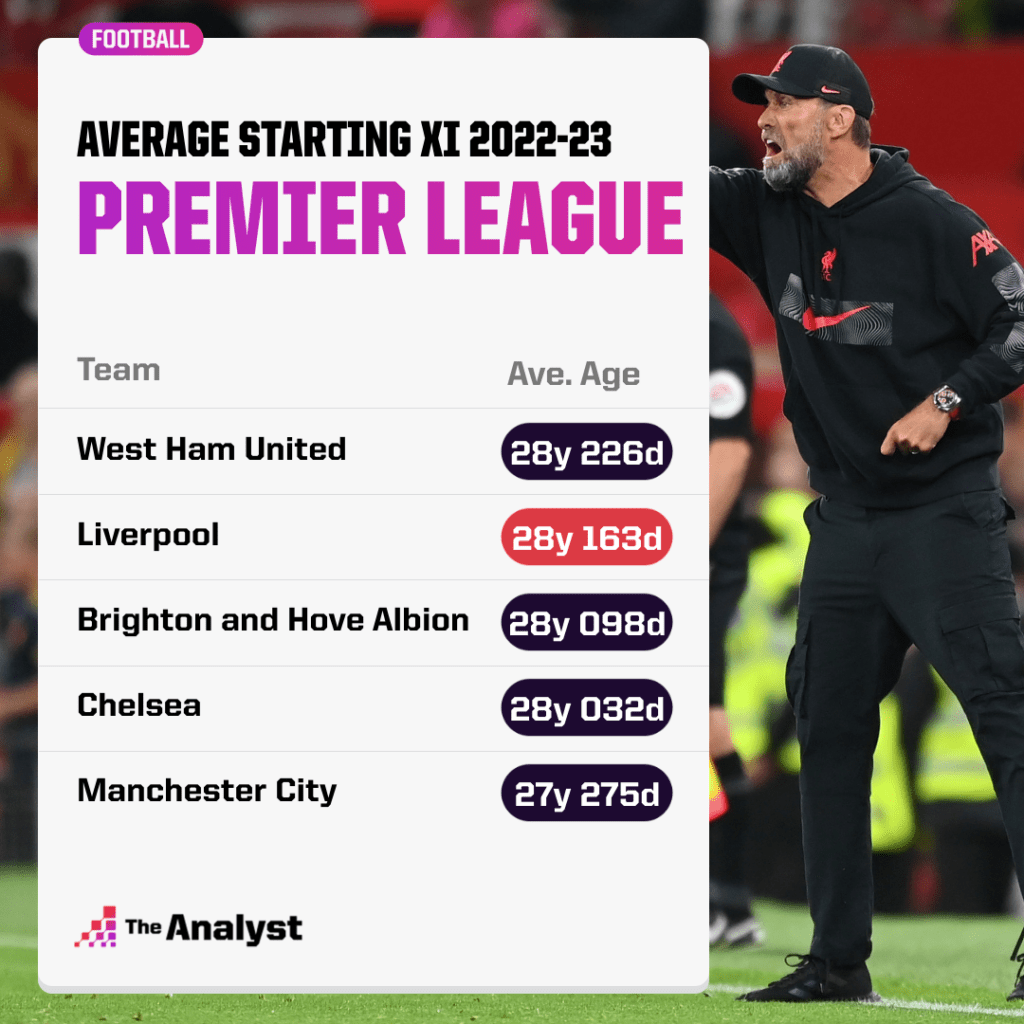
Remarkably, the starting XI that Liverpool named against Man City in the Community Shield was the club’s oldest on average for a competitive match (29y 315d) since the start of the 1953-54 season. Not to make alarm bells ring amongst Kopites, but Liverpool were relegated at the end that campaign.
All this brings us to the midfield.
Where do you start? For months, there has been so much talk about Liverpool’s midfield. There is a clamour among supporters for the Reds to sign a midfielder. Or two. Or three.
Klopp was asked about his midfield options pre-match before the defeat to Man Utd.
“Yes [I am happy], when they are all fit, 100 per cent. But even then, we always look to strengthen, we have to and we always did. It must be the right player and if the right player is not available in this moment then we tend to say, ‘OK, then we deal with what we have before we sign a player who is not 100 per cent right.’ This situation never changed. Now we have more injuries than we would have imagined and now it would be cool to have a new midfielder in, of course.”
There’s plenty to pick out in that quote. So, let’s look at the facts.
Since the start of last season, Liverpool have started no fewer than nine different players in a central midfield role in the Premier League. Only Crystal Palace (10) have more in this time. That’s nine players for just three different positions.
One of the nine was Tyler Morton, who has since been loaned to Blackburn Rovers. However, joining Liverpool this season is Fábio Carvalho, who while yet to start for the Reds, has come on as a substitute in midfield. So that arguably keeps Liverpool’s midfield options at nine for this season.
Nine players vying for three positions is hardly short. So when Klopp says he is 100% happy when all are fit, he’s right to be. How many other teams have such depth? Even Man City, famed for their impressive squad options, have seven senior players to choose from in midfield (Silva, Gündogan, Rodri, De Bruyne, Phillips, Grealish, Foden – though the latter duo are largely considered as attackers in City’s current setup). That’s two fewer than Liverpool, who many claim are ‘short’ in this regard.
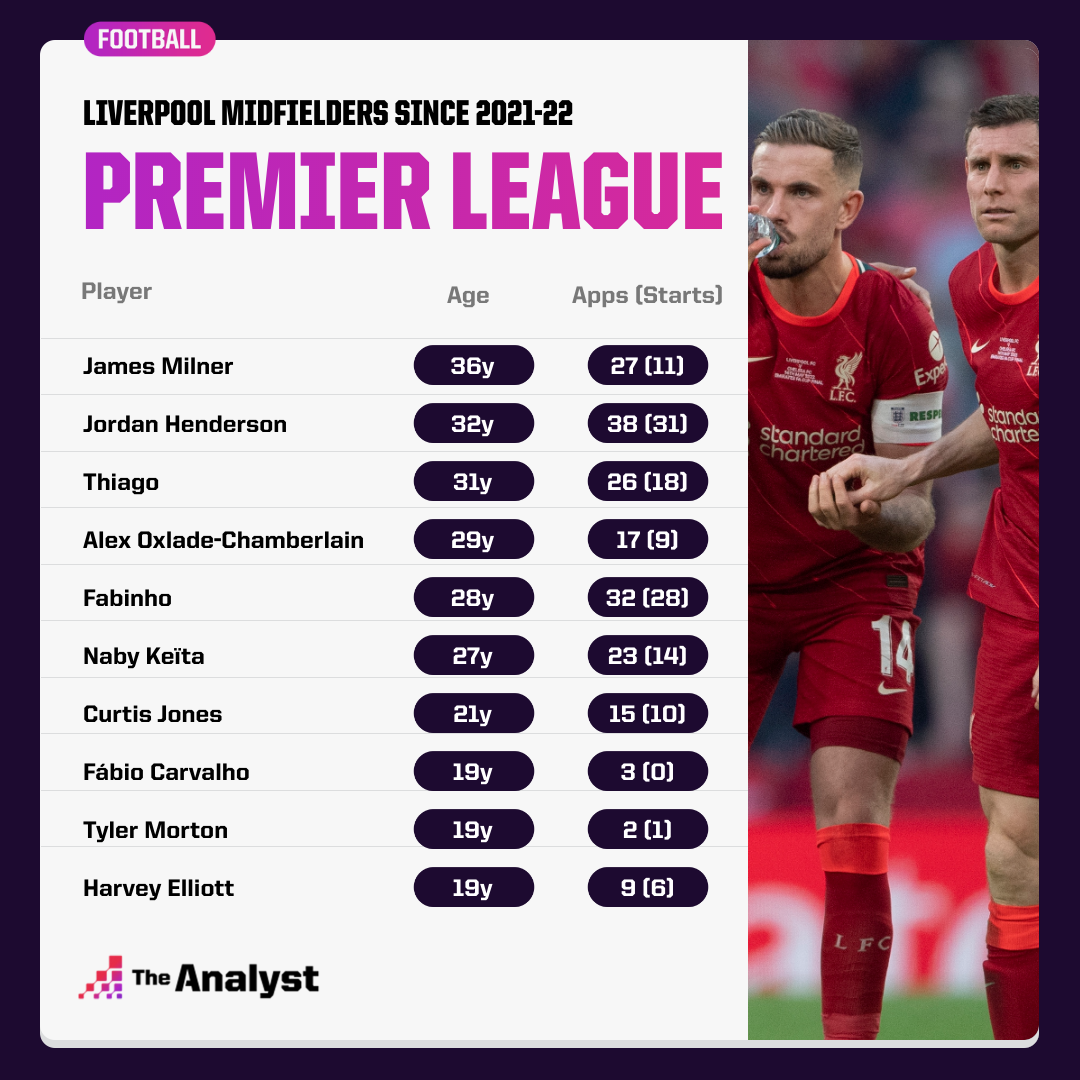
Looking at the age profile of Liverpool’s midfield options, you can practically split the nine players into three categories, a bit like an X Factor bootcamp, if you will. You have the experienced over 30s: Milner (36), Henderson (32), and Thiago (31). Next, you have the youngsters: Jones (21), Carvalho (19), and Elliott (19). And finally, you have the ones in what many would say are a players’ peak age range: Oxlade-Chamberlain (29), Fabinho (28,) and Keïta (27).
That’s plenty of options for now, but with Milner, Oxlade-Chamberlain and Keïta all out of contract at the end of this season, and Henderson and Thiago both in their 30s, it’s an area Liverpool have to address. Not necessarily right now – all five of those players are going nowhere for this season. But in a year’s time, the picture could, and likely will, look different. Two of the three ‘peak age’ players may well have left, as well as Milner; even he can’t go on forever. And there’s a noticeable gap of players aged from 22-26 in the fold.
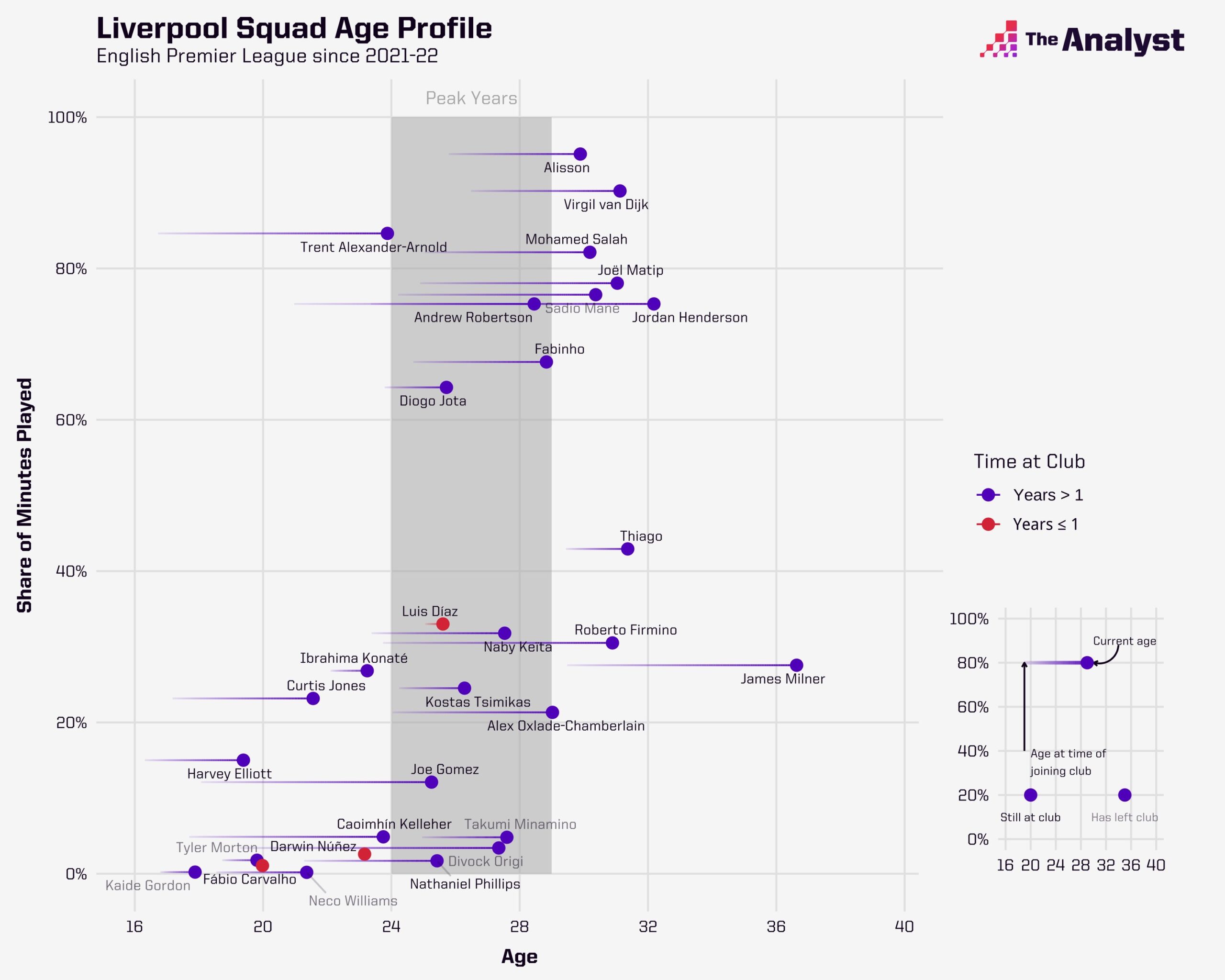
What concerns many in the short term for this season, though, is that old caveat. “When they are all fit,” as Klopp put it. Thiago, Oxlade-Chamberlain, Keïta and Jones were all missing for Liverpool’s game against Man Utd. It left Klopp with little options to play with. Which without doubt contributed to the defeat.
Keïta and Oxlade-Chamberlain have struggled with injuries. In what is their fifth and sixth seasons at the club respectively, neither have yet managed to start even half of Liverpool’s Premier League matches over a season, with 16 starts being Keïta’s most (2018-19) and 17 for Oxlade-Chamberlain (2019-20). At their ages, both late 20s, they should be in the peak of their careers. But consistent setbacks have meant that neither have been quite able to make a regular midfield spot their own. Both, as it stands, are out of contract at the end of the season.
When you look at the overall appearance data of Liverpool’s midfielders in the Premier League since the start of last season, you can see the lack of consistency throughout. Only Fabinho and Henderson have made 20 or more starts. Only that pair and Thiago have started four or more consecutive league matches for the club in this time. Klopp has regularly had to shuffle his pack in midfield.
The job of being a midfielder in this Liverpool side is a unique one. A midfielder for Klopp’s Liverpool is a facilitator for the attacking players and for the full backs, Andy Robertson and Trent Alexander-Arnold. They provide the creativity, while forwards such as Mohamed Salah, Diogo Jota and, in the past, Sadio Mané provide the cutting edge.
Indeed, the goal and assist contributions of Liverpool’s current midfield crop under Klopp in the Premier League is modest at best.
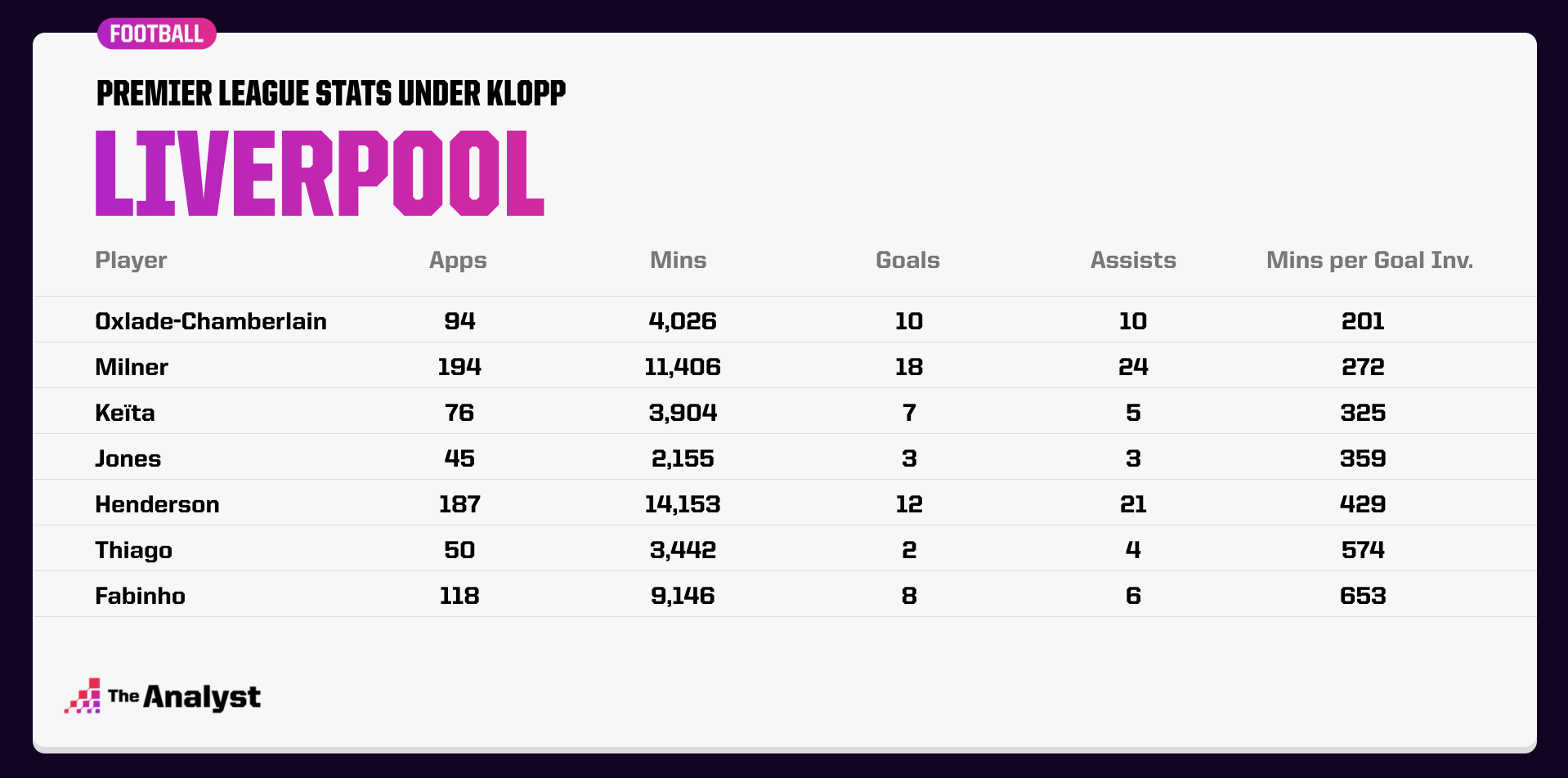
Oxlade-Chamberlain ranks top in this regard, averaging a goal involvement every 201 minutes. Milner is the only other in the list to average below 300 minutes per goal contribution – aided by him once being the club’s designated penalty taker.
Rather than end product, each of Liverpool’s midfielders offers something different. Since the start of last season, Fabinho tops the club’s midfielders for interceptions, Henderson has won possession most, Milner covers the most distance per 90, Elliott creates the most chances per 90.
But one of the set stands out above the rest: Thiago.
The Spaniard joined the Reds from Bayern Munich in 2020. While injuries, behind-closed-doors football and Liverpool’s poor form saw his first season struggle to get going at first, since the start of last season he has starred. He tops Liverpool midfield players for per-90 minute averages in passing, forward passing, long passing, progressive carries, and ball retention in this period. He is also in the top two for passing accuracy, interceptions and possession won. A true maestro in midfield.
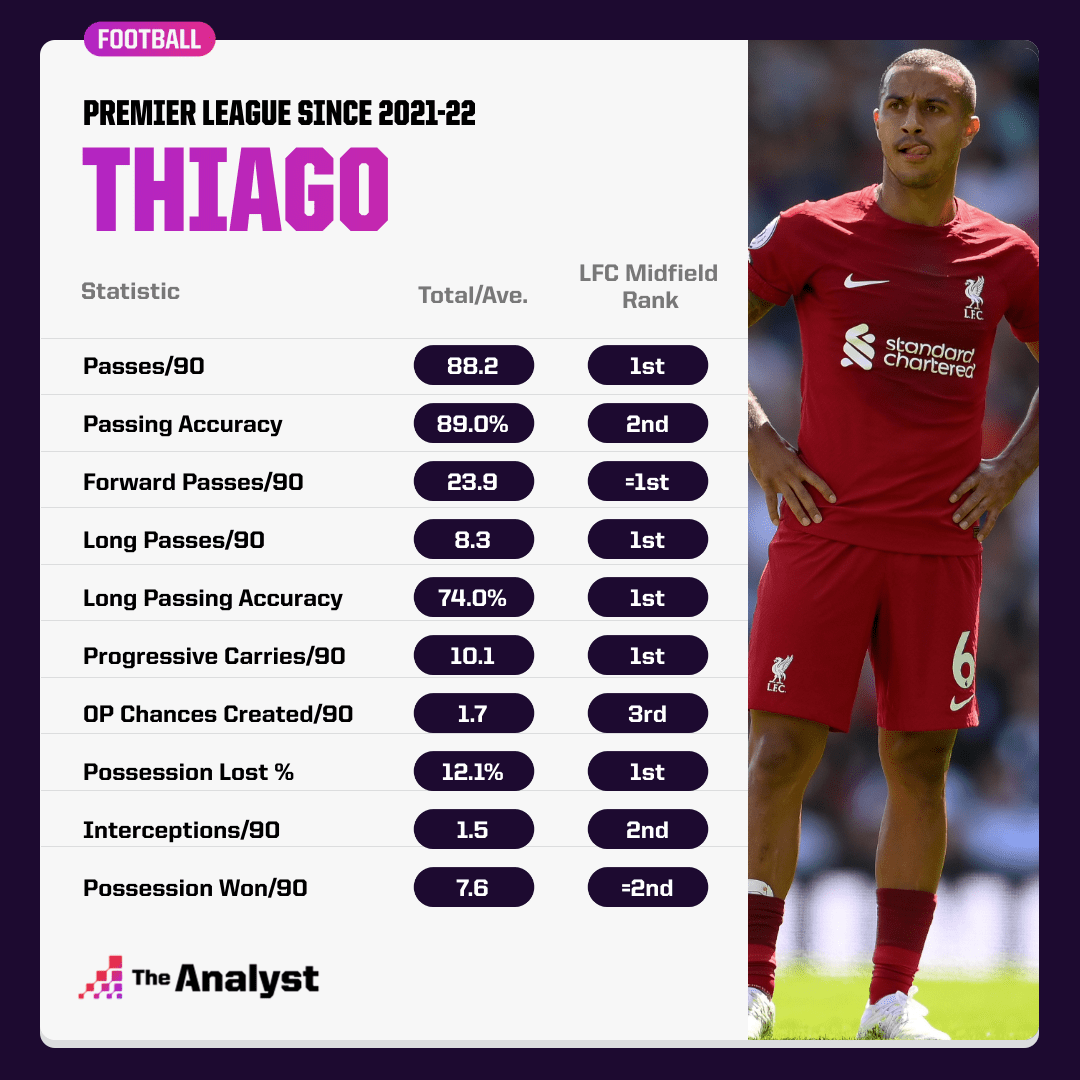
It’s no wonder, then, that Liverpool are unbeaten in the last 27 Premier League games that Thiago has started. He hasn’t lost a league match in which he has started since March 2021 against Chelsea. Liverpool have averaged 2.6 points/game during Thiago’s unbeaten run of starts; in the same period, this drops to 2.0/game when he hasn’t started.
Liverpool may have the numbers to cope for the all-too-frequent occasions in which Thiago isn’t fit to play, but perhaps lack the same level of quality.
It’s worth pointing out at this stage that Liverpool won the Champions League in 2019 and Premier League in 2020 without Thiago and with largely similar alternatives in midfield, with Thiago arguably replacing the since departed Georginio Wijnaldum. Liverpool also reached three cup finals and amassed 92 Premier League points last season with effectively the same midfield options they have now. It’s a high bar that has been set by Klopp’s men.
But Klopp has consistently developed and tweaked his Liverpool side year-on-year. 2017 brought the beginning of the famous front three of Salah, Mané and Roberto Firmino. In 2018, Fabinho, Virgil van Dijk and goalkeeper Alisson balanced out that electric attack with a more stable defensive setup. In 2019, the full backs hit their peak in providing assists. Thiago was the next development with his midfield ball progression in 2021. This year, Mané has departed to be replaced by the new stage of Liverpool’s attack, Luis Díaz and Darwin Núñez.
With that in mind, one can assume that the next chapter in the progression of this Liverpool side is the midfield.
The short-term reality for this season, though, is that Liverpool still have nine midfield options. Another signing now would bring them to double figures. It’s not quantity that’s needed now. Clubs can’t sign players just in case they have four, five, six injuries in the same position. As Klopp said, “It must be the right player and if the right player is not available in this moment then we tend to say, ‘OK, then we deal with what we have before we sign a player who is not 100 per cent right.’”
Liverpool have room in the mid-to-long term for the ‘right player’. But it would mean creating a short-term stockpile of players. Remember, Liverpool found enough depth last season to reach every single cup final possible and still amass 92 Premier League points. The ‘right player’ would surely, therefore, have to be someone to improve upon what they already have, not just add another body that may take up game time for the younger talents such as Elliott, Carvalho and Jones.
It’s worth pointing out at this stage that Jones is, statistically speaking, one of Liverpool’s closer alternatives stylistically to Thiago. Preferring to operate from the left of the midfield three, like Thiago, he is the only one of Liverpool’s midfielders who ranks above his Spanish counterpart for his passing accuracy, both overall and in the final third. Along with Keïta, he is also closest to Thiago when it comes to his ability to carry the ball upfield while maintaining a high level of ball retention. Considering Jones is only 21 with room to improve, he should not be discredited among the conversation about Liverpool’s midfield.
But let’s go back to Liverpool’s search for the ‘right player.’ And address the elephant in the room.
One name is mentioned more than any other with regards to who commentators feel Liverpool should look towards. Jude Bellingham. The Borussia Dortmund man is only 19, younger in fact than any midfielder mentioned in this piece but is closing in on 100 appearances for the German club.
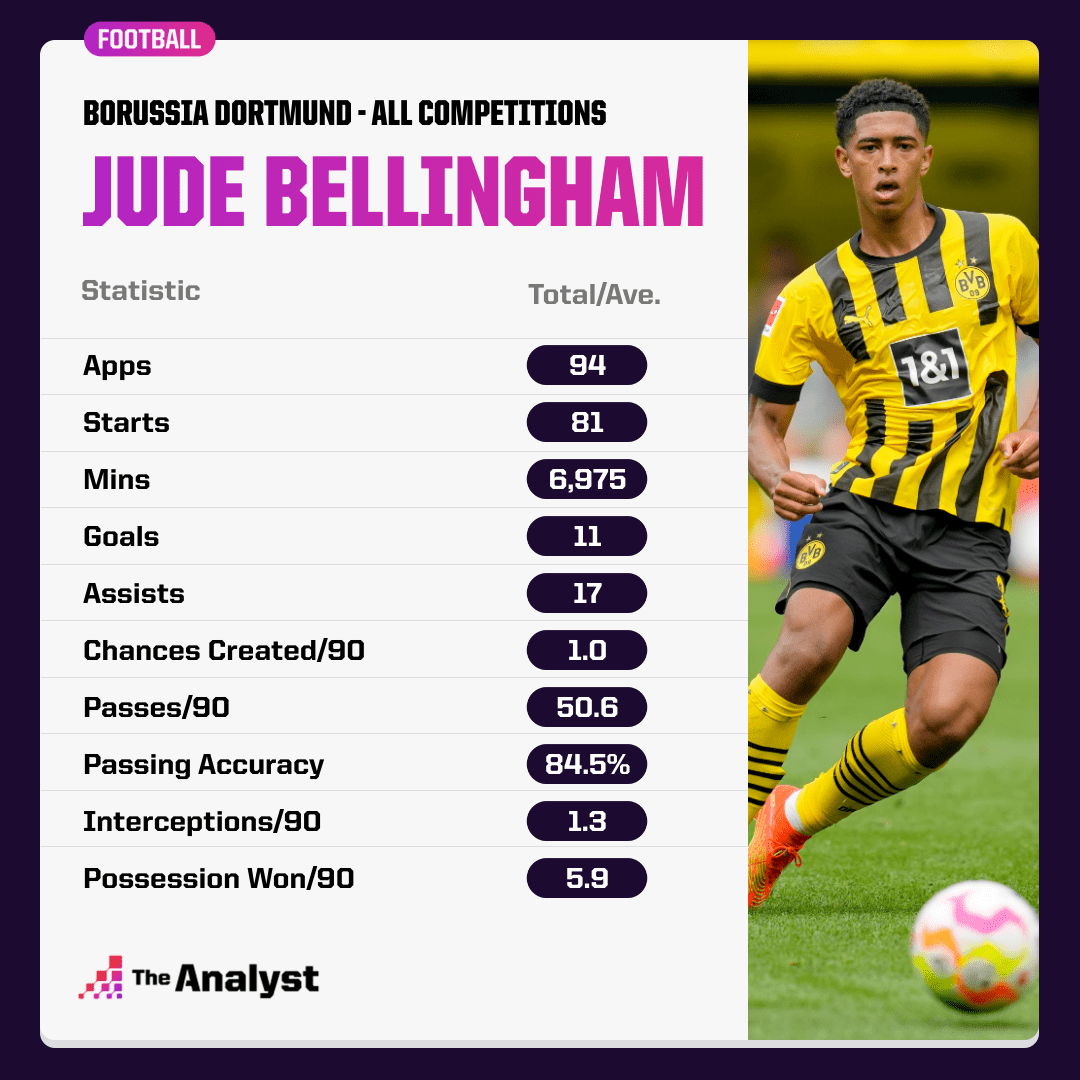
After losing Erling Haaland to Man City this summer, Dortmund are clearly averse to selling another of their stars in the same window. Which means Liverpool, and the many other top European clubs who will no doubt be keen on Bellingham, will have to wait at least another year to attempt to secure his services.
And there lies the dilemma. Liverpool would need to wait a year to try to sign a player they have no guarantee of being able to bring in, such will be the cost and competition to do so. But would signing a midfielder now limit the club’s financial ability to move for Bellingham next summer?
The counter-argument would be the possibility that Liverpool lose three of their current midfield crop in a year (Milner, Oxlade-Chamberlain and Keïta) should none sign a new deal. That would leave the Reds surely needing more than one midfield addition.
But for the 2022-23 season, those players are all Liverpool’s. Klopp still has his nine midfield options. The same players that helped the club to record-breaking success last season and in previous years.
The situation is compared by some to when Liverpool had a centre back crisis in 2021, with van Dijk, Joel Matip and Joe Gomez all out injured. Liverpool, therefore, brought in Ozan Kabak and Ben Davies that January simply to ensure they had the numbers to see out the campaign.
Klopp gave a similar quote about the centre back search then to his midfield quote now: “The whole time we are busy checking specific things in the market. We always did and do it now as well, and we will see if something happens or not. In an ideal world it would be great that the short-term solution is the long-term solution as well. I don’t know if we can do that, but we will see.”
The current midfield requirements, though, are different. While Liverpool do have injury issues at present, that won’t last the entirety of the season. The likes of Thiago, Keïta and Jones will be fit again. Liverpool will use all nine of their midfielders over the course of the campaign. It isn’t quantity that they need this time. It’s quality for the future.
The “short-term solution” would have to be the “long-term solution” too.
Enjoy this? Subscribe to our mailing list to receive exclusive weekly content
